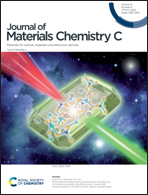Distinctive Ce3+ luminescence from single-crystalline and glassy Ce:LaB3O6†
Abstract
Ce3+ luminescence depends on both the composition and the structure of host materials, whereas the role of the structure is still not well understood. In this work, Ce:LaB3O6 (LBO) in both single crystalline and glassy forms are synthesized, and their distinctive photoluminescence (PL) and X-ray radioluminescence (XRL) are compared and discussed for the first time from the points of view of structure and defects. Crystalline Ce:LBO exhibits a very narrow PL band centered at 303 nm and a small Stokes shift of 3098 cm−1, while the glassy Ce:LBO emission is broad and bluish, peaking at 396 nm, with a larger Stokes shift of 4778 cm−1. The PL of crystalline Ce:LBO is constant over the whole cryogenic temperature range until the steep Mott–Seitz quenching mechanism starts even below RT. Its PL decay is characterized by a short and single-exponential lifetime of about 15 ns, corresponding to a quantum efficiency (QE) of ∼50%. In contrast, glassy Ce:LBO shows an even higher QE but its PL decreases gradually from the He temperature up until 400 °C with a bi-exponential decay characteristic. Moreover, radio- and thermo-luminescence measurements indicate the presence of a much larger population of defects in glassy than in crystalline Ce:LBO. All the observed luminescence differences mainly stem from the distinct local structures of Ce3+, being a unique single-site in a regular periodic lattice in the case of crystalline Ce:LBO and non-equivalent sites in amorphous glassy Ce:LBO, as found by means of X-ray atomic pair-distribution function analysis and high-resolution transmission electron microscopy. These results provide new insights into the host structure's contribution to the dopant's luminescence properties.



 Please wait while we load your content...
Please wait while we load your content...